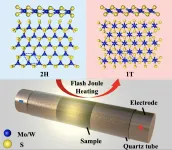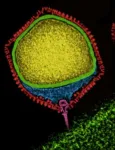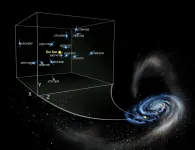(Press-News.org) HOUSTON - (Jan. 11, 2021) - Rice University scientists have extended their technique to produce graphene in a flash to tailor the properties of other 2D materials.
The labs of chemist James Tour and materials theorist Boris Yakobson reported in the American Chemical Society's ACS Nano they have successfully "flashed" bulk amounts of 2D dichalcogenides, changing them from semiconductors to metallics.
Such materials are valuable for electronics, catalysis and as lubricants, among other applications.
The process employs flash Joule heating -- using an electrical charge to dramatically raise the material's temperature -- to convert semiconducting molybdenum disulfide and tungsten disulfide. The duration of the pulse and select additives can also control the now-metallic products' properties.
"This rapid process permits us to make an entirely new class of highly valued materials in large scale and without the use of solvents or water," Tour said.
Two-dimensional dichalcogenides look like hexagonal graphene from above, but viewing them from an angle reveals a sandwichlike structure. In molybdenum disulfide, for instance, a single plane of molybdenum atoms sits between similar, but offset, planes of sulfur.
Making each material in its metallic phase (known as 1T) previously required far more complex processes, according to the researchers. Even then, the products were known to be unstable in ambient conditions. Flash Joule heating appears to solve that problem, producing metastable dichalcogenides in a thousandth of a second.
Powdered, commercially available dichalcogenides mixed with carbon black or tungsten powder to increase their conductivity were placed in a ceramic tube capped with electrodes and flashed with more than 1,350 amps of power for a fraction of a second, then rapidly cooled. With the tube under vacuum, extraneous gases were vented, leaving mostly pure metallics to be harvested.
According to the Yakobson team's calculations, the large energy input forces structural defects to appear in the materials' crystal lattices, adding negative charges that make 1T the thermodynamically preferred phase.
"It is an interesting fast-forward incarnation of Le Chatelier's principle: Under voltage, the material changes to a more conducting 1T phase, to counteract/reduce the applied electric fields," said co-author Ksenia Bets, a researcher in the Yakobson group. "Our detailed computations reveal that the kinetic path is indirect: The sublimating sulfur creates a vacancy-rich lattice that energetically prefers a 1T structure."
The fact that conditions and additives can influence the final product should lead to a systematic study about possible variations, Tour said.
Rice graduate student Weiyin Chen is lead author of the paper. Additional co-authors are Rice graduate students Zhe Wang, Emily McHugh, Wala Algozeeb and Jinhang Chen; postdoctoral researchers Duy Xuan Luong and Bing Deng; alumni Muqing Ren and Michael Stanford; assistant research professor Hua Guo; research scientist Guanhui Gao; and undergraduates John Tianci Li and William Carsten.
Tour is the T.T. and W.F. Chao Chair in Chemistry as well as a professor of computer science and of materials science and nanoengineering. Yakobson is the Karl F. Hasselmann Professor of Materials Science and NanoEngineering and a professor of chemistry.
The Air Force Office of Scientific Research, the Department of Energy (DOE) National Energy Technology Laboratory and DOE Basic Energy Sciences supported the research.
INFORMATION:
Read the abstract at https://pubs.acs.org/doi/10.1021/acsnano.0c08460.
This news release can be found online at https://news.rice.edu/2021/01/11/rice-flashes-new-2d-materials/
Follow Rice News and Media Relations via Twitter @RiceUNews
Related materials:
Tour Group: http://www.jmtour.com
Yakobson Research Group: https://biygroup.blogs.rice.edu
Department of Chemistry: https://chemistry.rice.edu
Rice Department of Materials Science and Nanoengineering: https://msne.rice.edu
Images for download:
https://news-network.rice.edu/news/files/2020/12/1221_FLASH-1-WEB.jpg
Rice University scientists extended their technique to produce graphene in a flash to tailor the properties of 2D dichalcogenides molybdenum disulfide and tungsten disulfide, quickly turning them into metastable metallics for electronic and optical applications. (Credit: Tour Group/Rice University)
https://news-network.rice.edu/news/files/2020/12/1221_FLASH-2-WEB.jpg
An electron microscope image shows tungsten disulfide in its metastable 1T state. The orange dots represent sulfur atoms, the blue represent tungsten. Rice University scientists used flash Joule heating to tailor the properties of 2D dichalcogenides, quickly turning them into metastable metallics for electronic and optical applications. (Credit: Tour Group/Rice University)
Located on a 300-acre forested campus in Houston, Rice University is consistently ranked among the nation's top 20 universities by U.S. News & World Report. Rice has highly respected schools of Architecture, Business, Continuing Studies, Engineering, Humanities, Music, Natural Sciences and Social Sciences and is home to the Baker Institute for Public Policy. With 3,978 undergraduates and 3,192 graduate students, Rice's undergraduate student-to-faculty ratio is just under 6-to-1. Its residential college system builds close-knit communities and lifelong friendships, just one reason why Rice is ranked No. 1 for lots of race/class interaction and No. 1 for quality of life by the Princeton Review. Rice is also rated as a best value among private universities by Kiplinger's Personal Finance.
DURHAM, N.C. - A Duke-led team of scientists has developed a bio-compatible surgical patch that releases non-opioid painkillers directly to the site of a wound for days and then dissolves away.
The polymer patch provides a controlled release of a drug that blocks the enzyme COX-2 (cyclooxygenase-2,) which drives pain and inflammation. The study appears Jan. 10, 2021 in the Journal of Controlled Release.
When they started "We were making hernia meshes and different antimicrobial films," said Matthew Becker, the Hugo L. Blomquist professor chemistry at Duke, and last author on the paper. "We thought you could potentially put pain drugs or anesthetics in the film if you ...
A shapeshifting immune system protein called XCL1 evolved from a single-shape ancestor hundreds of millions of years ago. Now, researchers at the Medical College of Wisconsin (MCW) discovered the molecular basis for how this happened. In the process they uncovered principles that scientists can use to design purpose-built nanoscale transformers for use as biosensors, components of molecular machines, and even therapeutics. The findings were published today in Science. The primary and senior authors of the manuscript, respectively, are MCW researchers Acacia Dishman, MD-PhD student, and Brian Volkman, PhD, professor of biochemistry.
Molecular switches can be used to detect cancer, construct nanoscale machines, and even build cellular computers. ...
Scientists crafting a nickel-based catalyst used in making hydrogen fuel built it one atomic layer at a time to gain full control over its chemical properties. But the finished material didn't behave as they expected: As one version of the catalyst went about its work, the top-most layer of atoms rearranged to form a new pattern, as if the square tiles that cover a floor had suddenly changed to hexagons.
But that's ok, they reported today, because understanding and controlling this surprising transformation gives them a new way to turn catalytic activity on and off and make good catalysts ...
Women who use marijuana could have a more difficult time conceiving a child than women who do not use marijuana, suggests a study by researchers at the National Institutes of Health. Marijuana use among the women's partners--which could have influenced conception rates--was not studied. The researchers were led by Sunni L. Mumford, Ph.D., of the Epidemiology Branch in NIH's Eunice Kennedy Shriver National Institute of Child Health and Human Development. The study appears in Human Reproduction.
The women were part of a larger group trying to conceive after one or two prior miscarriages. Women who said they used cannabis products--marijuana or hashish--in the weeks before pregnancy, or who had positive urine tests for cannabis ...
Scientists have used a "galaxy-sized" space observatory to find possible hints of a unique signal from gravitational waves, or the powerful ripples that course through the universe and warp the fabric of space and time itself.
The new findings, which appeared recently in The Astrophysical Journal Letters, hail from a U.S. and Canadian project called the North American Nanohertz Observatory for Gravitational Waves (NANOGrav).
For over 13 years, NANOGrav researchers have pored over the light streaming from dozens of pulsars spread throughout the Milky ...
Nothing in biology is static. Biological processes fluctuate over time, and if we are to put together an accurate picture of cells, tissues, organs etc., we have to take into account their temporal patterns. In fact, this effort has given rise to an entire field of study known as "chronobiology".
The liver is a prime example. Everything we eat or drink is eventually processed there to separate nutrients from waste and regulate the body's metabolic balance. In fact, the liver as a whole is extensively time-regulated, and this pattern is orchestrated by the so-called ...
EAST LANSING, Mich. - Michigan State University is leading a global research effort to offer the first worldwide view of how climate change could affect water availability and drought severity in the decades to come.
By the late 21st century, global land area and population facing extreme droughts could more than double -- increasing from 3% during 1976-2005 to 7%-8%, according to Yadu Pokhrel, associate professor of civil and environmental engineering in MSU's College of Engineering, and lead author of the research published in Nature Climate Change.
"More and more people will suffer from extreme droughts if a medium-to-high level of global warming ...
Researchers at Columbia University Mailman School of Public Health developed an infectious disease early warning system that includes areas lacking health clinics participating in infectious disease surveillance. The approach compensates for existing gaps by optimally assigning surveillance sites that support better observation and prediction of the spread of an outbreak, including to areas remaining without surveillance. Details are published in the journal Nature Communications.
The research team, including Jeffrey Shaman and Sen Pei, have been at the forefront of forecasting and analyzing the spread of COVID-19. Their ...
Fast facts:
This study describes essential differences between marine and freshwater species and the contributions of viruses to such differences
The results may help guide future bioengineering efforts to develop plant strains adapted to grow in salt-water, which is of local and regional food security interest
Microalgae are fundamental to global ecosystems due to their ability to sustain coral reef species and produce atmospheric oxygen
Before this study, many important algal phyla did not have sequenced representatives
Viruses have contributed to the evolution of algae and their genome makeups
Abu Dhabi, UAE, January 11, 2021: NYU Abu Dhabi (NYUAD) ...
It is well known that the expansion of the universe is accelerating due to a mysterious dark energy. Within galaxies, stars also experience an acceleration, though this is due to some combination of dark matter and the stellar density. In a new study to be published in Astrophysical Journal Letters researchers have now obtained the first direct measurement of the average acceleration taking place within our home galaxy, the Milky Way. Led by Sukanya Chakrabarti at the Institute for Advanced Study with collaborators from Rochester Institute of Technology, University of Rochester, and ...



